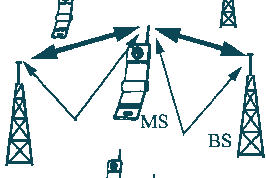

We address the case that the channel between a single base station and the user is a non-dispersive
line-of-sight channel. The signal from base station A is received with amplitude a and the signal from B is received with amplitude b.
Self-Interference Limited
The signal to interference ratio is (a/b)2 and (b/a)2, respectively.
According to the maximum ratio combining diversity principle, we amplify with (a/b) and (b/a), respectively.
That is, if the strongest signal is from A, it is boosted with (a/b)2 relative to the signal from B.
AWG Noise Limited
If the cross correlation of the codes is perfectly zero, and only AWGN noise is present, we amplify with (a) and (b), respectively. In the latter case, if the strongest signal is from A, it is boosted with (a/b) relative to the signal from B.
Back to soft handovers.





